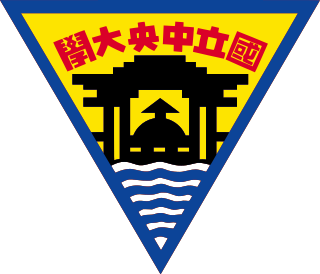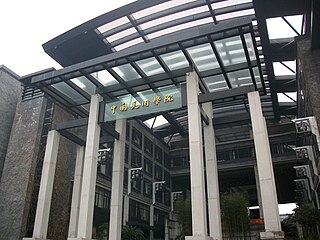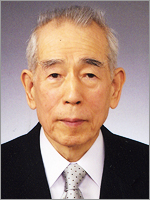Related Research Articles

The Chinese Buddhist canon refers to the total body of Buddhist literature deemed canonical in Chinese, Japanese, Korean and Vietnamese Buddhism. The traditional term for the canon.

National Central University is a public research university with long-standing traditions based in Taiwan. It was founded in 1915. The school was initially located in Miaoli when it first moved to Taiwan, but relocated to Zhongli in 1962 and developed into a comprehensive university. It's the first university in Taiwan to research industrial economics and economic development. NCU is a member of AACSB. NCU as one of the national six universities in research selected by the Ministry of Education.

China Academy of Art, also translated as China National Academy of Fine Arts, was founded in Hangzhou in 1928 by the government of the Republic of China and the renowned educator Cai Yuanpei. It was the first art university and first graduate school in Chinese history. In 2016, the Academy has been approved to be jointly-administrated by Zhejiang Provincial Government, the Ministry of Education and the Ministry of Culture. It is a Chinese state Double First Class University Plan university.

A metal leaf, also called composition leaf or schlagmetal, is a thin foil used for gilding and other forms of decoration. Metal leaves can come in many different shades. Some metal leaves may look like gold leaf but do not contain any real gold. This type of metal leaf is often referred to as imitation leaf.

C.N. Liew is born in Kuala Lumpur, Malaysia. His ancestral roots hails from Shenzhen Bao'an. C.N. is a pioneer in the field of Contemporary Ink in South East Asia.
Tanabe Hisao Prize was created in 1983 by the Tōyō Ongaku Gakkai, the oldest musicological society of Japan. The prize is named after the musicologist Tanabe Hisao, one of the founding members of the society. The prize is awarded annually to one or several individuals or groups who have published an outstanding work of Asian musicology during the previous year, one that "promotes further research in Asian musicology and contributes to Japanese scholarship." It is generally considered the most prestigious award in the field of Asian musicology awarded in Japan.

Tatsuo Nishida was a professor at Kyoto University. His work encompasses research on a variety of Tibeto-Burman languages, he made great contributions in particular to the deciphering of the Tangut language.

Differing literary and colloquial readings for certain Chinese characters are a common feature of many Chinese varieties, and the reading distinctions for these linguistic doublets often typify a dialect group. Literary readings are usually used in loanwords, names, literary works, and in formal settings, while colloquial/vernacular readings are usually used in everyday vernacular speech.
Ken-ichi Takashima is, according to the editors of the Thesaurus Linguae Sinicae, "the world's leading authority on Shang dynasty oracle bone inscriptions".
I Lo-fen is a Taiwanese scholar and writer. She received her Chinese Literature Ph.D. from National Taiwan University. She has been an associate professor in the Division of Chinese in Nanyang Technological University’s School of Humanities and Social Sciences since July 2006, and was the Head of the Division (2014-2016). She had formerly committed in institutes like the National Taiwan University, Tamkang University, Fu Jen Catholic University, and the Institute of Chinese Literature and Philosophy at Academia Sinica. In addition, she was also a visiting professor at Stanford University in the United States and East Asian Institute at Sungkyunkwan University, South Korea. Her research expertise lies in Text and Image Studies, Su Shi studies, East Asian literature and intercultural exchanges in Classical Chinese, and Singapore literature, history, and arts studies. She is also a board member of the China Su Shi Studies Society, and an international board member of the Korea Society of East Asian Comparative Literature. She is the Founder and Honorary President of the "Text and Image Studies Society"(文图学会) that was official registered in Singapore on 18 December 2017. By integrating the history of Chinese literature and arts, she has accomplished a series of researches on poems in paintings and poetic imagery. She then proposed the idea of the “Text and Image Studies”(文图学) and focused on the relations, comparison and intertextuality between poems and paintings. From there, she has established her literary theory in arts creation and culture of aesthetics. She is also a column writer of Singapore Lianhe Zaobao (2007-), and she hosts podcast "Lofen says".
Yu Min was an influential Chinese linguist, a 1940 graduate of the Fu Jen Catholic University, Chinese Department, a former professor of Yenching University, and professor of Beijing Normal University. His primary research areas were Chinese historical linguistics, Sino-Tibetan comparison, the study of Sanskrit in Chinese transcription. His collected writings were published posthumously in 1999.
Han Taiwanese or Taiwanese Han are a Taiwanese ethnic group, most of whom are of full or partial Han descent. According to the Executive Yuan of Taiwan, they comprise 95 to 97 percent of the Taiwanese population, which also includes Austronesians and other non-Han people. Major waves of Han immigration occurred since the 17th century to the end of Chinese Civil War in 1949, with the exception of the Japanese colonial period (1895-1945). Han Taiwanese mainly speak three languages of Chinese: Mandarin, Hokkien and Hakka.
Shehua is an unclassified Sinitic language spoken by the She people of Southeastern China. It is also called Shanha, San-hak (山哈) or Shanhahua (山哈话). Shehua speakers are located mainly in Fujian and Zhejiang provinces of Southeastern China, with smaller numbers of speakers in a few locations of Jiangxi, Guangdong and Anhui provinces.
Jun T. Lai is a Taiwanese artist, her practice includes sculpture, painting, public art, and other fields.

Philosophy in Taiwan is the set of philosophical traditions in Taiwan, while Taiwanese philosophy is taken to mean philosophical work from the country. Philosophical thought in Taiwan is diverse, drawing influence from Chinese philosophy during Qing rule from the 17th and 18th century, and Western philosophy through the Kyoto School during Japanese rule in the 19th and early 20th century. Taiwanese philosophy took a more endogenous turn during the modern era, with burgeoning philosophical debate regarding Taiwanese Gemeinschaft.

The Fujian–Taiwan relations, also known as the Min–Tai relations, refers to the relationship between Fujian, which is located in mainland China, and Taiwan, which is across the Taiwan Strait. Since the average width of the Taiwan Strait is 180 kilometers, Fujian and Taiwan are adjacent, similar in both climate and environment. Although the relationship between Taiwan and Fujian has changed with the development of history, the two places have maintained close relations in terms of personnel, economy, military, culture and other aspects. At present, Taiwan residents are mostly descendants of immigrants from mainland China, of which the southern Fujian ethnic group is the main group, accounting for 73.5% of Taiwan's total population. In terms of culture, language, religion, and customs, Fujian and Taiwan also share similarities.
Thomas Hong-Chi Lee (Chinese: 李弘祺; pinyin: Lǐ Hóngqí; Wade–Giles: Li3Hung2-chi2; Pe̍h-ōe-jī: Li Hông-kî; born March 5, 1945) is a Taiwanese-American historian of Chinese education and related aspects of traditional Chinese culture. He has taught world history and early modern European intellectual history in the US, as well as in Taiwan and in China.
National Yang Ming Chiao Tung University is a public research university in Taiwan. It was created in 2021 through the merger of National Yang-Ming University and National Chiao Tung University. At present, there are 19 colleges, 74 university/college level research centers, and 1 hospital in Yilan.
References
- ↑ 杜亞雄 (2006). "中國傳統音樂的分類和教學". 中國音樂學. 中國藝術研究院 (1): 80–81.
漢語中的傳統是指世代相傳的、具有特點的社會因素
- ↑ 周青青 (2003). 中國民間音樂概論. 人民音樂出版社. p. 1. ISBN 9787103026991.
常常把清代以前即已形成的音樂劃歸傳統音樂的範疇
楊子江 (2008). "傳統音樂分類法綜論". 中國音樂學. 中國藝術研究院 (3): 31.傳統音樂是個小於民族音樂的概念,指具有一定流傳時間、非當代創作的音樂,通常將清代之前形成的音樂歸入傳統音樂範疇。
- ↑ 林谷芳 (1998). 傳統音樂概論. 漢光文化事業股份有限公司. pp. 14–26. ISBN 9789576293054.
這種分類是依據音樂表現上所直接依據的型態,也就是音樂作品的本身來分類的……即所謂的:歌樂、器樂、歌舞音樂、說唱音樂、戲曲音樂和宗教音樂。……除了歌樂與器樂主要是以音樂為其表達核心外,上述其他的四類音樂都結合了另外一門藝術來呈現,至於宗教音
楊子江 (2008). "傳統音樂分類法綜論". 中國音樂學. 中國藝術研究院 (3): 33.袁靜芳等編著的《中國傳統音樂概論》,將傳統音樂總體劃分為民間音樂和宗教、祭祀音樂兩大類別。二級分類中,對民間音樂的分類沿襲了《概論》的劃分
杜亞雄 (2006). "中國傳統音樂的分類和教學". 中國音樂學. 中國藝術研究院 (1): 81.五大分類法即將傳統音樂分為歌曲、歌舞音樂、說唱音樂、戲曲和器樂。
袁靜芳 (2000). 中國傳統音樂概論. 上海音樂出版社. p. 284. ISBN 9787805538341.中國傳統器樂根據其演奏形式,主要包括獨奏音樂與合奏音樂兩大部分。
- ↑ 楊子江 (2008). "傳統音樂分類法綜論". 中國音樂學. 中國藝術研究院 (3): 34.
五大類分類法,依然是研究及教學的主要參考模式
- ↑ 杜亞雄 (2006). "中國傳統音樂的分類和教學". 中國音樂學. 中國藝術研究院 (1): 81.
有許多品種因為綜合了不同的表演形式,所以無法歸入五大類中的任何一類。
- ↑ 杜亞雄 (2006). "中國傳統音樂的分類和教學". 中國音樂學. 中國藝術研究院 (1): 82.
四大類分類法即按傳統音樂流行的社會層面將其分為民間音樂、文人音樂、宗教音樂和宮廷音樂四類的辦法
- ↑ 袁靜芳 (2000). 中國傳統音樂概論. 上海音樂出版社. pp. 346–401. ISBN 9787805538341.
樂種的主要類別與藝術特徵.....
- ↑ 王振复 (1998). 天人合一: 中華審美文化之魂. 上海文藝出版社. p. 184. ISBN 9787532113972.
在獨奏音樂中佔有最重要地位的古琴與琵琶,其音樂表現......
《中華傳統文化大觀》編纂委員會 (1993). 中華傳統文化大觀. 中國大百科全書出版社. p. 241.其中最為古老的獨奏音樂品種,當推古琴音樂
- ↑ 袁靜芳 (2000). 中國傳統音樂概論. 上海音樂出版社. pp. 295–346. ISBN 9787805538341.
獨奏音樂的主要類別與藝術特徵.....
- ↑ 施旭升 (2015). 戲曲文化學. 獨立作家-秀威出版. p. 25. ISBN 9789863263050.
崑曲和京劇都自成體系,堪稱典範......所以,此前曾有論者將崑曲作為中國傳統戲劇學的最高範型
秋文 (1988). 古中國的歌: 京劇演唱藝術賞析. 寶文堂書店. p. 32. ISBN 9787800300011.當時北京崑曲和京劇為雅部和花部兩大支柱,代表了中國古典戲劇的兩大歷史髙峰。
- ↑ 袁靜芳 (2000). 中國傳統音樂概論. 上海音樂出版社. pp. 204–281. ISBN 9787805538341.
戲曲音樂.....
- ↑ 袁靜芳 (2000). 中國傳統音樂概論. 上海音樂出版社. pp. 112–117. ISBN 9787805538341.
韓蕓霞; 肖學俊 (2017). "十二木卡姆研究綜述(1949-2015)(一)". 新疆藝術學院學報. 新疆藝術學院 (1).{{cite journal}}: CS1 maint: multiple names: authors list (link)